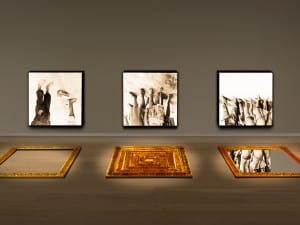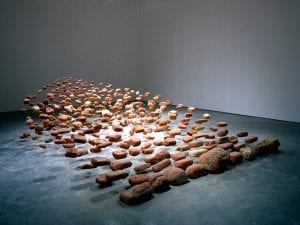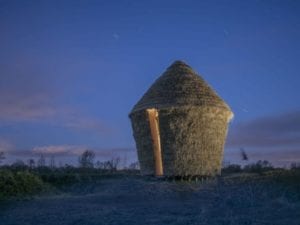The National Gallery of Victoria International (NGV International), Melbourne, is currently home to Jamie North’s (b.1971) latest exhibition Rock Melt. North’s practice involves sculptural cement-based works that are entwined with luscious plant life. The appealing contrast between these two elements tells a story of the relationships between nature and architecture, erosion and transformation. The environment, both natural and man-made, is North’s most significant influence. He shares a family history with the steel, mining and building industries, interpreting these interests in his sculpture. Primary materials include concrete and recycled slag – a bi-product of smelting iron ore. With a constantly changing repertoire, North regularly comes across new discoveries.
The work on view at NGV International is an installation that sits within Federation Court. The piece includes six columns that stand vertically at various heights with some being as tall as five meters. Each column contains plant life that seemingly sprouts from different areas. North explains that Rock Melt is concerned with “maintaining the suggestion of form in the absence of materiality, hence the way in which each column starts with a very solid base and becomes progressively less so as the forms increase in height.” The plant seen in the display is called Pandorea pandorana (Wonga Wonga Vine) and it was specifically chosen to trace the vertical form: “over time, this vine becomes very woody and will meld with sculpture, blurring the distinction between the organic and the inorganic and becoming part of the works structure.” Throughout the duration of the show, the plants continue their trajectory; they often change and may possibly produce blooming flowers.
The creation process from the initial stages is tenuous and requires much thought, care and concentration. As North explains, “the process begins by modelling the work on paper or in a program, then constructing a steel armature if needed and making the form mouldings, which are typically made from plywood or cardboard. Then the detailed mouldings are made from clay and the larger aggregates that will be exposed in the final sculpture.” North thinks of the mouldings as negative sculpture, as the positive or “end” piece is determined by this crucial stage: “once this negative sculpture is completed, the concrete mix is poured in, vibrated and left to cure before being stripped. Final finishing involves scraping away the clay which in my mind is reminiscent of an archaeological process, as the material placements and decisions behind these are revealed.” High pressure water is then used to clean away the remaining clay.
The plants positioned within the man-made pylons comfortably complement one another. The process which the concrete undergoes lends it an almost organic and aestheticised appearance, making it a suitable-looking object to support the growth of organic life. There is a feel of rejuvenation expressed in the installation as the plants spread life, suggestive of the progression of time. A new stem begins to materialise and take control, defining its valuable and necessary purpose as it seeks room to expand.
Organic matter bursts through concrete pathways, brick buildings and asphalt roads. Plants are determined to break through, even in some of the most unexpected places. It does not take long for built areas to be overrun by plants if they are not maintained. When asked what North hopes his viewers will take with them after observing his work, he responds: “I never want to be too prescriptive, though I would like viewers to see complexity behind the apparent simplicity of the work. That means considering the distinctions between such things as the man-made and the natural, resilience and fragility, and the exotic and the indigenous.”
Jamie North: Rock Melt, until 12 July, The National Gallery of Victoria, 180 St Kilda Road, Melbourne, Victoria, 3006, Australia.
Sara Sweet
For more information visit www.ngv.vic.gov.au.
Follow us on Twitter @AestheticaMag for the latest news in contemporary art and culture.
Credits
1. Jamie North, Flume, 2013 (detail) © Jamie North. Courtesy of the artist and Ashley Barber.





